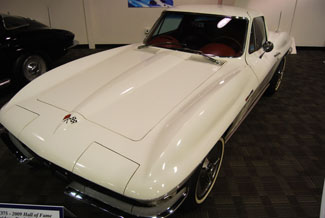Corvette History 
Select a year and a model to view the vast history of Corvettes.
All Models

For 1965, the Corvette had slightly changed styling. There were three functional, slanting louvers on the sides of the front fenders; a blacked-out horizontal-bars grille and different rocker panel moldings. A restyled hood without indentations was standard, but Corvettes fitted with an optional new 396-cid “big-block” V-8 used a special hood with a funnel-shaped “power blister” air scoop.
Inside the ‘Vette, the instruments were changed to a flat-dial, straight-needle design that reflected an aircraft-type design influence. The seats had improved support and one-piece molded inside door panels were introduced.
Standard equipment included a full set of gauges including a tachometer; safety belts; a heater and defroster; a windshield washer; an outside rear view mirror; dual exhausts; an electric clock; carpeting; a manually-operated top (on convertibles) and interior sun visors. A four-wheel disc-brake system was standard, although drum brakes could be substituted for a $64.50 credit.
Fuel injection was offered, but was phased out at the end of the ‘65 model year. New options included a nasty-looking side exhaust system and telescoping steering wheel. Eight exterior colors were available: Tuxedo Black; Ermine White; Nassau Blue; Glen Green; Milano Maroon; Silver Pearl; Rally Red and Goldwood Yellow. All convertibles came with a choice of a Black, White or Beige soft top. Interior colors were Black, Red, Blue, Saddle, Silver, White, Green and Maroon.
Two Sting Ray body styles were offered. Model 19437 was the coupe, which again had a fastback design. It listed for $3,947 with standard equipment. That was slightly more than $1 per pound, since it tipped the scale at 3,570 lbs. Chevrolet produced 8,187 coupes. The Model 19467 convertible proved to be a bit more popular—and 15,377 of the ragtops were made. The convertible was priced lower ($3,212), but weighed more (3,645 lbs.).
Standard in Corvettes was a 327-cid V-8 with a 4.00 x 3.25 bore and stroke, a 10.5:1 compression ratio and a Carter four-barrel carburetor. It was rated for 250 hp at 4400 rpm and 360 lbs.-ft. of torque at 2800 rpm. There were several optional versions of the 327. The L75 option (300 hp @ 5000 rpm and 360 lbs.-ft. at 3200 rpm had a different AFB type Carter four-barrel. The L79 option (350 hp @ 5800 rpm and 360 lb.-ft. @ 3600 rpm) had a higher 11.0:1 compression ratio and a Holley four-barrel. The L76 option (365 hp @ 6200 rpm and 350 lb.-ft. @ 4000 rpm) had a high-lift cam and solid valve .lifters. The L84 version (375 hp @ 6200 rpm and 350 lb.-ft. @ 4400 rpm) added Ram-Jet fuel injection and was the last optional Corvette “fuelie” engine.
The most powerful engine option was a 396-cid big-block V-8 with a 4.094 x 3.76 inch bore and stroke. It used an 11.00:1 compression ratio, mechanical lifters, a high-lift cam and a Holley four-barrel. It was good for 425 hp @ 6400 rpm and 415 lb.-ft. of torque at 4000 rpm.
Standard in Corvettes was a three-speed manual all-synchromesh transmission with floor-mounted gear shifter. You could order three other gearboxes: A two-speed Powerglide automatic transmission with floor-mounted gear shifter; a high-performance Muncie all-synchromesh four-speed manual transmission with floor-mounted gear shifter or a version of Muncie’s special close-ratio four-speed transmission with floor-mounted gear shifter.
The ’65 Corvette retained a 96-in. wheelbase. The convertible was 175.2 inches long and the coupe was 175.3 inches long. Overall height and width for a coupe were 49.8 inches and 69.6 inches. The front tread (56.8 inches) was a little narrower than the rear (57.6 inches). Ground clearance with standard equipment 7.75 x 15. tires was five inches.
The Corvette used a full-length steel ladder type frame with five cross members and separate fiberglass body. Independent upper and lower A-arms, unequal-length wishbones; coil springs; an anti-roll bar and tubular shocks made up the front suspension. An independent rear suspension had a fixed differential; nine leaf springs; lateral struts and universally-jointed axle shafts; radius arms and direct-acting shock absorbers. Rear axle ratios were: 3.36:1 (standard) and 4.11:1; 4.56:1; 3.08:1; 3.55:1; 3.70:1 (all optional).
Most 1965 Corvettes (89.6 percent) were sold with a four-speed manual transmission; 8.6 percent had Powerglide automatic transmission; 69.5 percent had tinted glass; 10.3 percent had air conditioning and 13.7 percent had power steering. An L78-powered 1965 Corvette could go from 0-to-60 mph in 5.7 seconds and from 0-to-100 mph in 13.4 seconds.
The beginning engine numbers were 0001001 and up at each assembly plant with F=Flint, Mich. and T=Tonawanda, N.Y. Corvette engines have the last six digits of the VIN stamped on the block next to the engine number. The body number plate was located on the engine side of the cowl. The Fisher Body Style Number 65-19467 identifies a Corvette Sting Ray convertible and the Fisher Body Style Number 65-19437 identifies a Corvette Sting Ray coupe. The Body Number is the production serial number of the body. A Trim Number indicates the interior trim color and material.